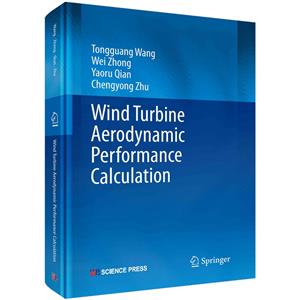掃一掃
關注中圖網
官方微博
本類五星書更多>
-
>
宇宙、量子和人類心靈
-
>
氣候文明史
-
>
南極100天
-
>
考研數學專題練1200題
-
>
希格斯:“上帝粒子”的發明與發現
-
>
神農架疊層石:10多億年前遠古海洋微生物建造的大堡礁
-
>
聲音簡史
風力機空氣動力性能計算方法(英文版) 版權信息
- ISBN:9787030777720
- 條形碼:9787030777720 ; 978-7-03-077772-0
- 裝幀:精裝
- 冊數:暫無
- 重量:暫無
- 所屬分類:>
風力機空氣動力性能計算方法(英文版) 內容簡介
本書全面介紹風力機氣動性能計算的主流方法,兼顧學術性與工程實用性。首先介紹風力機的空氣動力學基礎,包括流體力學基本原理、翼型的氣動特性、幾個重要風力機模型的試驗和計算數據等;然后詳細論述葉素動量方法、渦尾跡方法和計算流體力學(CFD)方法如何用于風力機氣動性能的計算。其中,葉素動量方法是風力機氣動性能計算、載荷計算和氣動外形設計中*廣泛應用的工程計算方法;渦尾跡方法可以計算出風力機的三維繞流和尾流,能夠獲得空間的速度場,在風力機氣動性能計算的學術研究和工程應用方面占有重要地位;CFD方法通過數值離散求解流體控制方程,是一種通用的流場求解方法,可以獲得*全面和精細的風力機流場信息,是目前風力機空氣動力學研究方面不錯大的計算工具。在以上方法的論述過程中,本書盡可能融入了相關方法在學術研究上的近期新進展,計算公式的推導力求容易理解,整理出了清晰的計算流程并輔以計算實例。本書將與Springer出版社聯合出版。
風力機空氣動力性能計算方法(英文版) 目錄
ContentsPart 1 Fundamentals of Wind Turbine AerodynamicsChapter 1 Physical Properties of Air 31.1 Continuum assumption 3 1.2 Pressure, density, and temperature 41.2.1 Definitions of pressure, density, and temperature 41.2.2 Ideal gas equation of state 41.3 Compressibility, viscosity, and thermal conductivity 51.3.1 Compressibility 51.3.2 Viscosity 61.3.3 Thermal conductivity 81.4 Inviscid and incompressible assumptions. 81.4.1 Inviscid assumption 81.4.2 Incompressible assumption 9References 9Chapter 2 Description of Air Motion 102.1 Motion of fluid microelements 102.1.1 Analysis of fluid microelement motion 102.1.2 Velocity divergence and its physical meaning 132.1.3 Curl and velocity potential function 142.2 Continuity equation 152.3 Governing equations of inviscid flow. 162.3.1 Euler equations of motion 162.3.2 Bernoulli equation 192.4 Governing equations of viscous flow 212.5 Viscous boundary layer 232.5.1 Concept of the boundary layer 232.5.2 Boundary layer thickness 232.5.3 Pressure characteristics in the boundary layer 262.5.4 Boundary layer equations 262.5.5 Flow separation 272.6 Basic concepts of turbulence 282.7 Turbulent wind in the atmospheric boundary layer 312.7.1 Basic characteristics of the atmospheric boundary layer 312.7.2 Characteristics of the mean wind speed 322.7.3 Characteristics of turbulent wind 33References 34Chapter 3 Fundamentals of Airfoils 363.1 Airfoil geometry 363.1.1 Geometric parameters of airfoil 363.1.2 Numbering of typical airfoils 383.1.3 Parametric description of airfoil geometry 393.2 Aerodynamics of airfoils 403.2.1 Flow around airfoil 403.2.2 Aerodynamic coefficients of airfoil 423.2.3 Aerodynamic characteristics of airfoil 43References 45Part 2 Blade Element Momentum MethodChapter 4 Steady Blade Element Momentum Method 494.1 Momentum theory 494.2 BEM theory 524.3 Effect of blade number 564.4 Effect of high thrust coefficient 574.5 Iterative solution of BEM method 584.6 Calculation example 61References 63Chapter 5 Correction Models 655.1 Tip-loss correction models 655.1.1 Prandtl model655.1.2 Glauert series models 675.1.3 Goldstein model 685.1.4 Shen model 685.1.5 Zhong model 705.1.6 Blade-root correction 705.2 3 D rotational models 715.2.1 Category 1 models 72 5.2.2 Category 2 models 74 5.3 Dynamic stall models 755.3.1 Beddoes-Leishman model 775.3.2 ye model 865.3.3 ONERA model 875.3.4 Boeing-Vertol model 875.3.5 Coupling of dynamic stall model and 3D rotational effects 88References 91Chapter 6 Unsteady Blade Element Momentum Method 946.1 Coordinate transformation 946.2 Calculation of induced velocity 976.3 Dynamic inflow model 1006.4 Dynamic wake model 1016.5 Yaw/Tilt model 1026.6 Calculation steps of unsteady BEM method 103References 106Part 3 Vortex Wake MethodChapter 7 Fundamentals of Vortex Theory 1097.1 Vortex lines, vortex tubes, and vortex strength 1097.2 Velocity circulation and Stokes theorem 1117.3 Biot-Savart law 1157.4 Vortex models 1177.4.1 Model of vortex core 1177.4.2 Vortex core radius and dissipation model 1207.5 Helmholtz vortex theorem 1217.6 Kutta-Joukowski lift theorem 1227.6.1 Flow around a cylinder 1227.6.2 Circulation and lift 125References 126Chapter 8 Computational Models of Vortex Wake 1278.1 Definition of coordinate systems 1288.2 Models of vortices 1308.2.1 Models of vortices attached to blades 1308.2.2 Models of wake vortices 1318.3 PVW model 1348.4 FVW model 1368.4.1 Governing equations for vortex filaments 1368.4.2 Description of initial wake. 1368.5 Flow field computation 1378.5.1 Wake discretization 1378.5.2 Computation of attached vortex circulation 1388.5.3 Computation of rotor aerodynamic performance 1408.5.4 Computation of induced velocity 141References 144Chapter 9 Solving Aerodynamic Performance of Wind Turbines 1469.1 Solution of steady PVW model 1469.1.1 Solution process 1469.1.2 Computation example 1499.2 Solution of steady FVW model 1509.2.1 Relaxation iterative method 1509.2.2 Solution process 1529.2.3 Computation example 1539.3 Unsteady PVW method 1549.3.1 Calculation of inflow wind speed 1549.3.2 Induced velocities 1569.3.3 Coupling of dynamic stall models 1579.3.4 Computation example 1589.4 Unsteady FVW method. 1599.4.1 Time-stepping method 1599.4.2 Computation steps 1639.4.3 Computation example 163References 164Part 4 Computational Fluid Dynamics MethodChapter 10 Fundamentals of Computational Fluid Dynamics 16910.1 Brief introduction to CFD 16910.2 Mathematical description of incompressible viscous flow
展開全部
書友推薦
- >
詩經-先民的歌唱
- >
月亮虎
- >
企鵝口袋書系列·偉大的思想20:論自然選擇(英漢雙語)
- >
我從未如此眷戀人間
- >
李白與唐代文化
- >
上帝之肋:男人的真實旅程
- >
巴金-再思錄
- >
【精裝繪本】畫給孩子的中國神話
本類暢銷
















